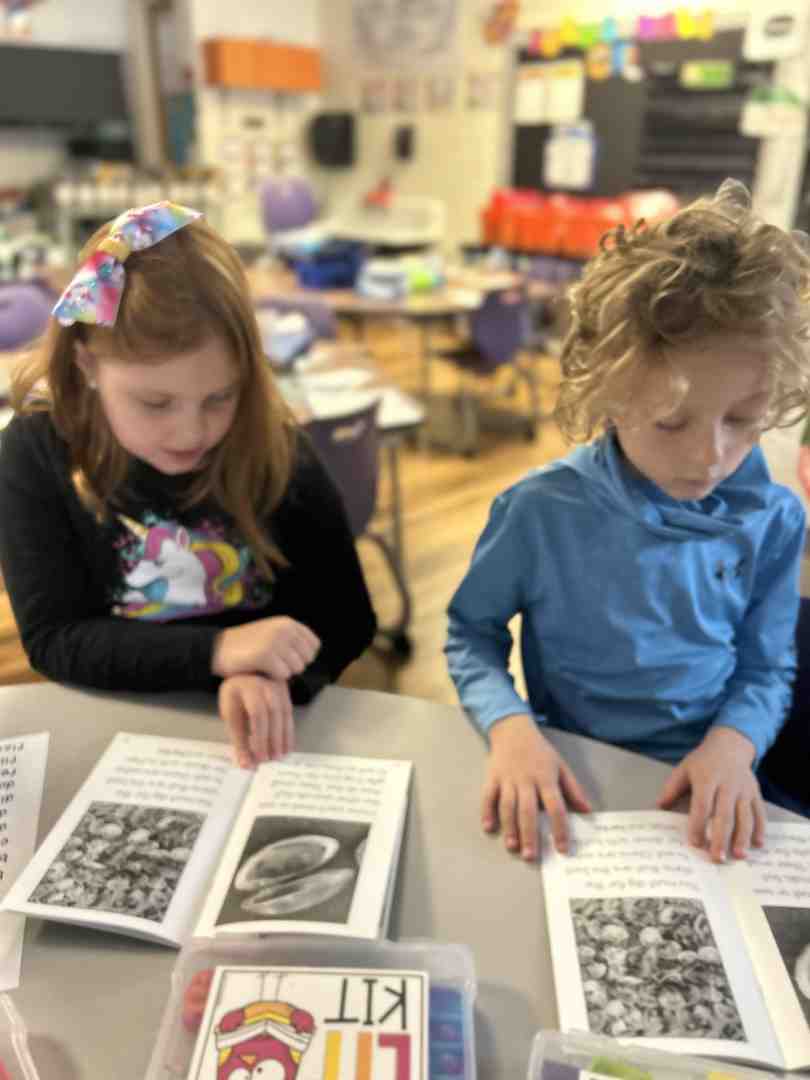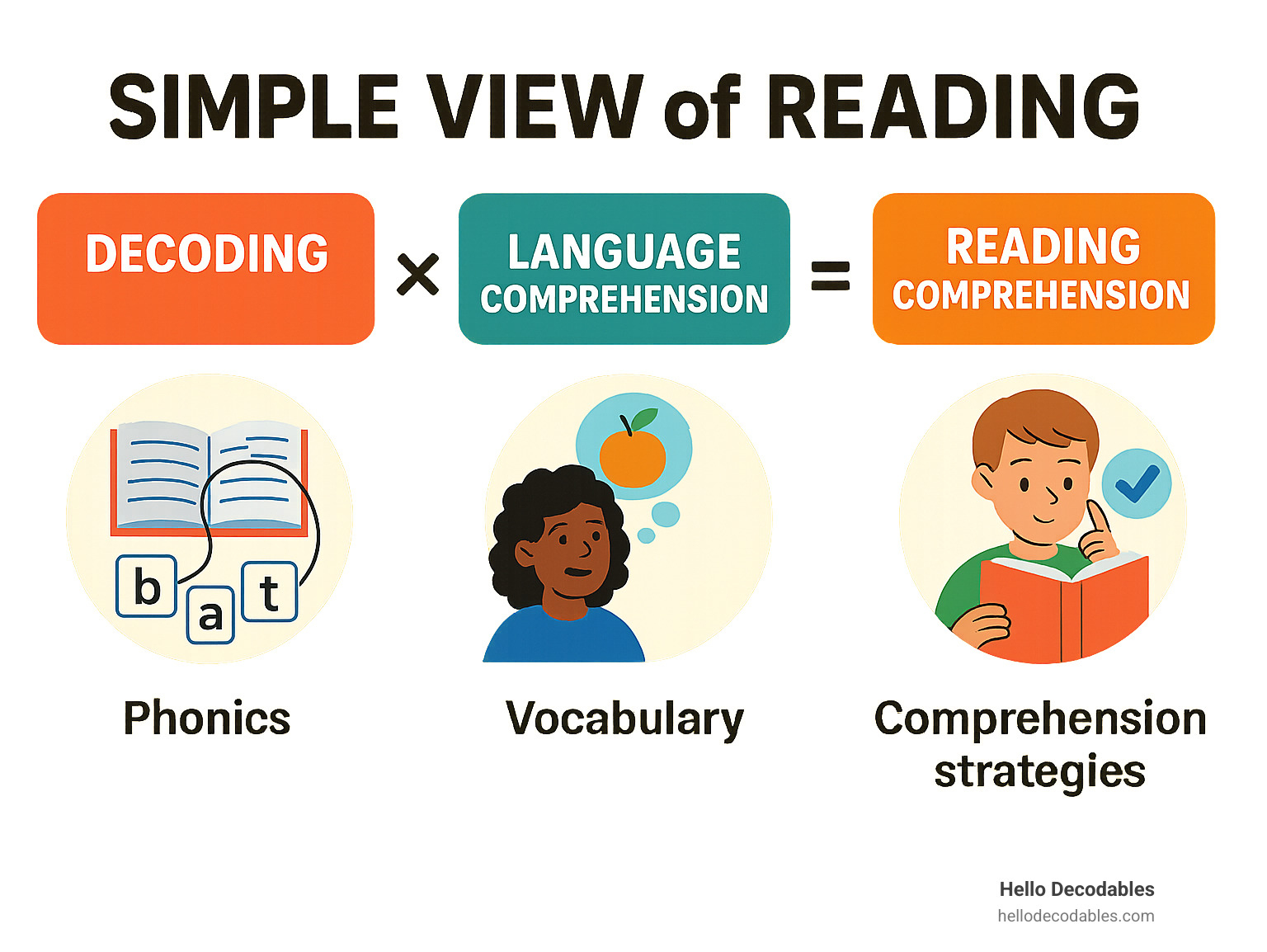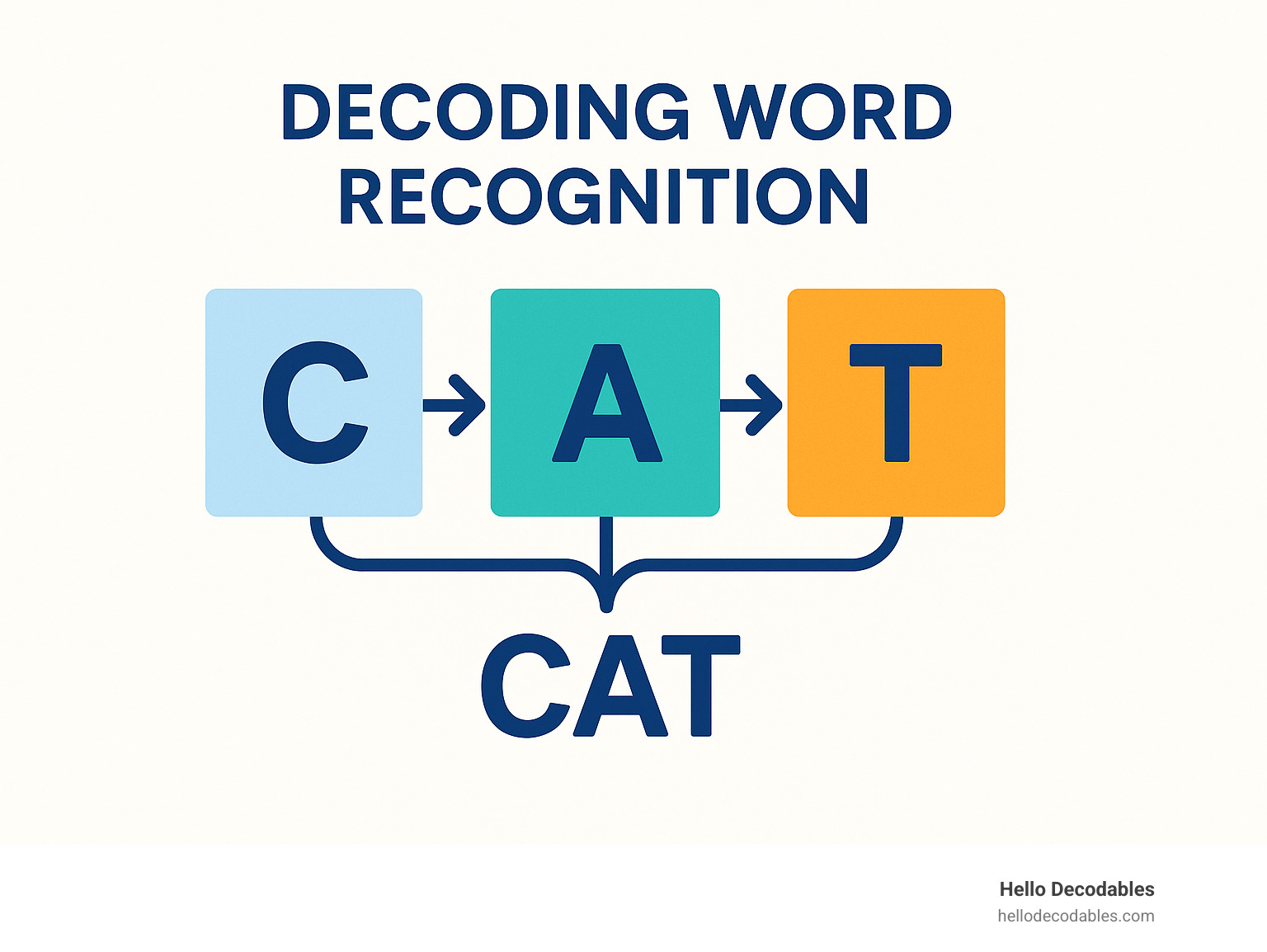
· By Jen Jones
What is Decoding and How Does it Unlock Word Recognition?
Cracking the Code of Reading
Decoding word recognition is the foundational skill that transforms written symbols into spoken language, enabling children to open up the meaning behind printed words. At its core, decoding involves applying knowledge of letter-sound relationships to pronounce unfamiliar words, while word recognition is the ultimate goal - the ability to identify words instantly and effortlessly.
Quick Answer: What is Decoding Word Recognition?
- Decoding: The process of translating letters and letter patterns into sounds
- Word Recognition: The ability to identify written words quickly and accurately
- The Connection: Successful decoding practice leads to automatic word recognition
- The Goal: Fluent reading with comprehension
Think of learning to read like cracking a secret code. Written language is essentially a code where letters and letter combinations represent the sounds we hear in spoken words. When children master this code-cracking process, they gain the key to independent reading success.
Research consistently shows that systematic phonics instruction is crucial for developing strong decoding skills. According to the National Reading Panel, students who receive explicit, systematic phonics instruction significantly outperform those who don't. The Simple View of Reading demonstrates that reading comprehension equals decoding ability multiplied by language comprehension - making decoding a non-negotiable foundation for literacy success.
As Jen Jones, founder of Hello Decodables with over 30 years in literacy education and certification in Orton-Gillingham structured literacy approaches, I've witnessed how mastering decoding word recognition transforms struggling readers into confident learners. My work with schools across 38 states has reinforced that when children understand the systematic relationship between sounds and letters, reading becomes accessible rather than mysterious.

The Foundational Skills: What is Decoding and How Does it Relate to Phonics?

Picture a child sitting at a table with colorful letter tiles, carefully arranging c-a-t to spell their first word. This simple moment captures the magic of decoding word recognition - the process where printed letters transform into meaningful spoken language.
Decoding is essentially the bridge between seeing squiggly marks on a page and understanding what they mean. When children decode, they apply their knowledge of letter-sound relationships to correctly pronounce written words. It's like having a secret decoder ring that turns mysterious symbols into familiar sounds.
At the heart of this process lies the alphabetic principle - the understanding that sounds in spoken words are represented by letters. Think about it: the sound /k/ can be represented by the letter 'c', 'k', or even 'ck'. These letters or groups of letters that represent sounds are called graphemes, while the actual sounds themselves are phonemes.
Here's where it gets interesting: English has only 26 letters but approximately 44 phonemes. This means we often need combinations of letters to represent single sounds. When children master these letter-sound correspondences, they hold the key to reading success.
The Crucial Role of Phonemic Awareness
Before children can connect letters to sounds, they need something even more fundamental: the ability to hear that spoken words are made up of individual sounds. This skill is called phonemic awareness - the ability to hear, identify, and manipulate phonemes in spoken words.
Think of it like learning to hear individual notes in a melody. If you can't hear the separate /c/, /a/, and /t/ sounds in the word "cat," how can you possibly map those sounds to the letters c-a-t? It's simply impossible.
Phonemic awareness serves as the first crucial step in decoding. Children need to master blending sounds together (/c/ + /a/ + /t/ = "cat") and segmenting sounds apart ("dog" = /d/ + /o/ + /g/). Without this foundation, even the best phonics instruction will struggle to take root.
The impact of this skill cannot be overstated. For a deeper dive into this connection, our article on Understanding the Impact: How Phonemic Awareness Improves Decoding Skills provides valuable insights for educators and parents alike.
Phonics: The Rules of the Written Code
While phonemic awareness deals with sounds we hear, phonics connects those sounds to written symbols. Phonics is the systematic method of teaching children the relationships between letters (or groups of letters) and their corresponding sounds, plus the rules for how words are spelled.
Every reader of English uses phonics knowledge to decode words. We learn that certain grapheme-phoneme correspondences are reliable, and we apply these patterns when we encounter new words. When a child sees the word "bat" for the first time and successfully sounds it out, they're applying phonics principles.
The research backing systematic instruction is overwhelming. The National Reading Panel's comprehensive review confirmed that systematic, explicit phonics instruction benefits all types of learners - not just struggling readers. Normally achieving students, at-risk students, and students with reading difficulties all show greater gains with systematic approaches compared to less structured methods. For further reading, informational articles on phonics from Reading Rockets offer additional perspectives on these instructional methods.
Decoding vs. Encoding: Two Sides of the Same Coin
Understanding decoding word recognition becomes clearer when we compare it to its partner skill: encoding. These are reciprocal abilities that strengthen each other, like two dancers moving in harmony.
| Aspect | Decoding (Reading) | Encoding (Spelling) |
|---|---|---|
| Direction | Print to speech | Speech to print |
| Process | Seeing "cat" and saying /c/-/a/-/t/ | Hearing "cat" and writing c-a-t |
| Skill Applied | Using letter-sound knowledge to read | Using letter-sound knowledge to spell |
Decoding takes written symbols and converts them into sounds we can pronounce. Encoding works in reverse, taking spoken sounds and converting them into written symbols. Both rely on the same foundation of grapheme-phoneme knowledge.
When children practice decoding words in their reading, they simultaneously reinforce the patterns they need for spelling. This connection between reading and writing creates a powerful learning loop that accelerates literacy development. It's why effective reading programs address both skills together, recognizing them as two sides of the same literacy coin.
The "How-To": Mastering Decoding Word Recognition with Systematic Instruction
Now that we understand what decoding word recognition is, how do we teach it effectively? The answer, backed by decades of research, is explicit and systematic instruction. This means we teach reading skills directly and logically, not just hope children pick them up through osmosis.
A surprising 60% of children need explicit, systematic, code-based instruction to learn how to read. Only a small 5% seem to learn effortlessly, and another 35% manage with relatively broad instruction. This means if we're not explicit in our teaching, we're tilting the odds against the majority of our young learners.
At Hello Decodables, our approach aligns with the Science of Reading, championing a structured way of guiding children into reading. We often use a teaching method called "gradual release," or "I do, We do, You do." First, the teacher shows how a skill works ("I do"). Then, everyone practices it together with support ("We do"). Finally, students try it on their own ("You do"). This step-by-step journey builds confidence and competence.
This systematic teaching weaves the crucial word recognition strand into what experts call Scarborough's Reading Rope. This model shows that skilled reading is like a braided rope, made of many intertwined skills, with decoding and language comprehension at its heart.
The Power of Explicit and Systematic Phonics
Explicit phonics instruction means we directly teach children the connections between letters and sounds and important spelling patterns, leaving no room for guessing.
Systematic phonics instruction means we teach these concepts in a carefully planned order, from simple to complex. We begin with basics like individual consonant sounds and short vowels, then move to trickier patterns such as digraphs (like 'sh', 'ch', 'th'), vowel teams (think 'ea' in 'peach' or 'ai' in 'rain'), and r-controlled vowels (like 'ar' in 'car' or 'er' in 'her').
This organized, step-by-step approach is powerful for preventing reading difficulties and helping struggling readers catch up. If you're curious to see more about how this structured literacy supports young readers, you can explore our insights on Decoding Success: How Structured Literacy Instruction Supports Readers. For a real-world look at a lesson, see this Structured Literacy Lesson (begins with a skill review), from Literacy How.
The Role of Decodable Texts in Building Fluency
Once children learn phonics patterns, they need a safe space to practice. That's where decodable texts shine. A decodable text is designed to mostly use letter-sound connections and phonics rules that students have already learned.
Unlike leveled readers that may encourage guessing from pictures, decodable texts guide children to sound out words using their phonics knowledge. This focused practice gives children opportunities to apply specific skills, boosting their decoding word recognition practice. They act like training wheels for reading, setting young readers up for success.
When reading feels successful, children gain confidence and are more excited to read. This repeated application builds fluency – the ability to read accurately, quickly, and with expression. It’s why Hello Decodables is passionate about our phonics-based decodable books; we believe in empowering children with the tools they need to succeed. You can also find other great resources like Jump Rope Readers that share this focus on decodability.
Effective Decoding Strategies and Activities
Beyond explicit lessons and decodable texts, many engaging activities can cement decoding word recognition skills. These hands-on experiences make the abstract concept of decoding more concrete and exciting for young learners:
- Making Words: Students use letter tiles to manipulate letters, learning how changing one creates a new word (e.g., "cat" to "bat"). They then sort words by spelling patterns to spot connections.
- Word Sorts: This activity involves grouping words by shared phonics patterns, like the 'sh' sound or a long 'a' vowel team. This helps students internalize patterns for decoding new words.
- Word Walls: A visual classroom display of high-frequency words or words with a common phonics pattern. Regular practice with the wall builds automaticity and helps students decode similar words.
- Keyword Decoding: This strategy, also called decoding by analogy, uses a memorable "keyword" for each spelling pattern. Students use the known keyword to decode new words with the same pattern (e.g., using "cat" to read "hat").
- Sound Boxes (Elkonin Boxes): A visual tool that helps students segment words into individual sounds. Students might push a counter into a box for each sound, connecting spoken sounds to a visual representation.
- Blending Drills: Direct practice in blending sounds to form words, starting simple and increasing in complexity (e.g., "s-a-t" becomes "sat"). Successive blending (/c/, /cl/, /clu/, /club/) is a powerful technique.
- Phoneme-Grapheme Mapping: This activity directly links sounds (phonemes) to their written symbols (graphemes). Students say a word, segment its sounds, and write the corresponding grapheme for each sound, building crucial neural pathways for reading. You can see a great example of Phoneme-Grapheme Mapping, from Literacy How.
These multi-sensory activities transform the abstract world of decoding into something tangible and exciting for every young learner.
From Practice to Proficiency: How Decoding Builds Comprehension and Literacy

We all know the ultimate goal of reading isn't just to say words, but to understand them! That's where comprehension comes in. So, how does all this talk about decoding word recognition actually help a child grasp the meaning of a story or a factual text? It's quite simple, really: when decoding becomes automatic, it frees up a child's brainpower for understanding.
Think of it like learning to ride a bike. At first, you're concentrating on every single pedal stroke, balancing, and steering. It's a lot of effort! But with practice, those actions become second nature. You can then focus on where you're going, the scenery, or even enjoy a chat with a friend. Reading works the same way. If a child is painstakingly sounding out every word, all their mental energy is consumed by that effort. This leaves very little room to think about what the text means. But when decoding word recognition becomes effortless, the reader's mind is free to focus on the story, the characters, and the big ideas. This reduction in "cognitive load" is key to building strong comprehension, just as the Simple View of Reading suggests.
From Decoding to Automatic Word Recognition
The journey from sounding out every letter to instantly recognizing words is truly remarkable! In the beginning, decoding is a conscious effort, a bit like solving a puzzle with each new word. But here's where the magic of practice comes in. Through repeated exposure and successful decoding, words start to "stick" in our long-term memory. This incredible process is known as orthographic mapping. It's how our brains create a direct connection between the letters in a word, its sounds, and its meaning.
Once a word is orthographically mapped, we recognize it instantly, almost like a flash. This isn't about memorizing thousands of words as unique pictures; it's about our brain building a vast, interconnected network of sounds and letters. This automaticity is the true hallmark of a fluent reader. It allows us to glide through texts, dedicating our attention to the narrative, the underlying message, and the beauty of the language itself.
Addressing Common Challenges in Decoding Word Recognition
Even with the very best instruction, some children might find decoding word recognition a bit trickier. It's completely normal for bumps to appear on the road to reading proficiency, and recognizing these signs is the first step to offering support.
You might notice a child guessing words based on the first letter, pictures, or even just the context, rather than truly sounding them out. For example, they might see 'house' and say 'home' because of an accompanying illustration. Another common sign is slow, labored reading, where every word feels like a mountain to climb, leading to a choppy pace and frequent pauses. This intense effort often drains their mental energy, making comprehension a real struggle. Sometimes, children might show inconsistent application of phonics, meaning they learn a rule one day but struggle to apply it consistently to new words or different texts. When reading becomes a constant uphill battle, it can lead to frustration and avoidance, turning what should be a joyful experience into a dreaded task.
These challenges can sometimes point to underlying learning differences, such as dyslexia. It’s important to remember that difficulties with decoding are a frequent characteristic of struggling readers, and they often impact fluency and comprehension. The wonderful news is that these challenges can absolutely be addressed with targeted, explicit, and systematic instruction. It's about patiently reinforcing those foundational skills until they become second nature. For more in-depth strategies to support struggling readers, you can explore valuable resources like those offered by Reading Rockets.
Differentiating Instruction for Diverse Learners
At Hello Decodables, we wholeheartedly believe that every learner is unique, and our teaching approaches need to reflect that beautiful diversity. This is especially true when it comes to nurturing strong decoding word recognition skills.
For our English Language Learners (ELLs), systematic phonics instruction is incredibly powerful in helping them decode words, even when their English oral language proficiency is still developing. However, decoding alone won't open up comprehension if the words they're reading are tied to concepts or vocabulary they don't yet understand. That’s why phonics instruction must be woven together with rich oral language development, including robust vocabulary building and expanding their background knowledge. Many ELLs bring incredible strengths with them, including transferable literacy skills from their home language, especially if their native language uses an alphabetic script. Understanding these existing strengths can significantly boost their English literacy development. We also find that multisensory approaches, which engage multiple senses like sight, sound, touch, and movement, are wonderfully beneficial for all learners, including ELLs. They provide diverse pathways for new information to stick in the brain. And don't forget the power of pre-teaching vocabulary from texts – it’s a simple yet effective way to bridge the gap between decoding and comprehension for ELLs. For even more insightful strategies and support for English Language Learners, Colorín Colorado provides excellent resources on Phonics support for English Language Learners from Colorín Colorado.
Frequently Asked Questions about Decoding and Word Recognition
We often hear common questions about how children learn to read, especially when it comes to decoding word recognition. Let's clear up some of the most frequent queries to help you better understand this crucial skill.
What is the difference between phonics and decoding?
This is a fantastic and very common question! While often used interchangeably, phonics and decoding are actually distinct concepts, though they work hand-in-hand.
Think of it this way: Phonics is the knowledge itself. It's the set of rules and principles that teach us how letters and groups of letters (graphemes) represent sounds (phonemes). It's understanding that the letter 'c' often makes a /k/ sound, or that 'sh' makes a /sh/ sound. Phonics gives us the blueprint for the written language.
Decoding, on the other hand, is the action or the application of that knowledge. When a child sees an unfamiliar word like "clap," and they use their phonics knowledge to blend the sounds /c/-/l/-/a/-/p/ together to read the word "clap," they are decoding. So, phonics is the "what you know," and decoding is the "what you do with that knowledge" to sound out and pronounce words. One builds on the other!
Why can't some words be decoded with phonics?
It's true, while the vast majority of English words – around 84% – can be decoded using phonics rules, there are some words that don't always play by the rules. These are often called "trick words," "irregular words," or high-frequency words that simply don't follow typical phonetic patterns.
Words like "said," "of," "the," "was," and "are" are great examples. If you tried to sound out "of" purely using phonics as /o/-/f/, you'd get "off," not the correct pronunciation "uv." For these specific words, relying solely on phonics won't lead to the correct pronunciation. That's why these words are typically taught as sight words. Children learn to recognize them instantly, often through memorization, because they appear so frequently in texts.
However, even many "irregular" words often have some decodable parts. For instance, in "said," the 's' and 'd' are regular. A strong phonics foundation helps children even with these tricky words, as they can decode the parts that do follow the rules and then focus on memorizing the irregular part.
How long should decoding skills be taught?
Decoding word recognition instruction should definitely begin early, right in kindergarten and 1st grade. This is when systematic phonics instruction is most beneficial and sets the stage for future reading success. Think of it as laying a strong foundation for a house – you want to get it right from the start!
However, the journey doesn't end there. Research consistently shows the value of extending code-based instruction beyond first grade. This isn't just for students who are struggling; even those with a strong grasp of basic skills can benefit from continued, systematic reinforcement and application of decoding strategies.
The goal is to ensure that decoding becomes automatic and effortless. When children can decode words without conscious effort, their mental energy is freed up to focus on the true joy of reading: understanding the story, learning new information, and building comprehension. So, while the most explicit teaching happens early, the continued practice and refinement of decoding skills are important throughout elementary school and even into middle school for students who need that extra support. It's all about building confident, proficient readers for life!
Conclusion: Open uping a Lifetime of Reading Success
Throughout this journey, we've uncovered the essential elements of decoding word recognition - from the building blocks of phonemic awareness and phonics to the transformative moment when these skills become automatic and open the door to true reading comprehension. What we've finded is both simple and profound: reading isn't magic, and it's not something children naturally absorb just by being around books. Instead, it's a learnable skill that requires thoughtful, systematic teaching.
Decoding is absolutely a non-negotiable skill. Without it, children remain locked out of independent reading, forever dependent on others to access written information. But when children master the code - when they can effortlessly translate those squiggles on the page into meaningful words - something wonderful happens. Their minds are finally free to dive into stories, explore new ideas, and build the knowledge that will serve them throughout their lives.
The research is crystal clear: systematic, explicit instruction works. It works for the 60% of children who absolutely need it to learn to read, and it benefits everyone else too. When we teach phonics systematically, use decodable texts that let children practice their growing skills, and provide plenty of opportunities for application, we're setting up every child for success.
This is exactly why Hello Decodables exists. We've seen how the right approach can transform a struggling reader into a confident one. Our phonics-based decodable books aren't just teaching tools - they're stepping stones that help children build the neural pathways necessary for fluent reading. Each book is carefully crafted to align with the Science of Reading, ensuring that children can apply what they've learned in phonics lessons to real reading experiences.
We believe deeply that every child deserves to experience the joy and independence that comes with being able to read. No child should be left guessing at words or feeling frustrated by books that are beyond their decoding abilities. When we provide the right foundation and the right practice materials, we're not just teaching reading - we're opening up endless possibilities for learning, growth, and findy.
Ready to support your young readers on this incredible journey? Explore our library of decodable books to build decoding skills and give every child the tools they need to crack the reading code and open up a lifetime of literacy success.
